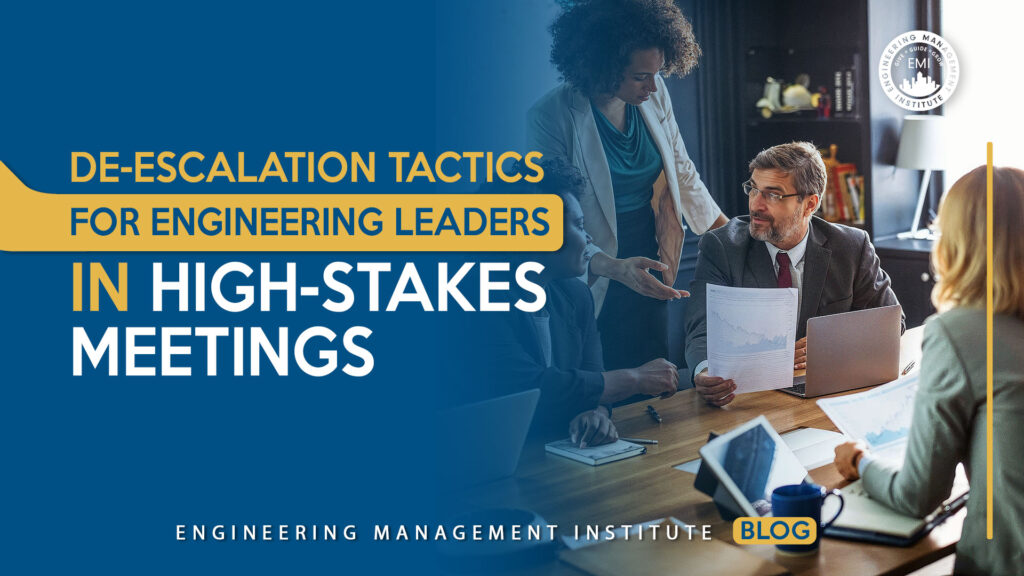I was in a meeting that was about to go supercritical; The VP of Product was red-faced, jabbing a finger at a graph on the screen, “The data pipeline is a liability! Your team’s latency is costing us revenue every hour!” My lead engineer, Greg, shot back, “Because you keep shoving in new, half-baked requirements without a spec! It’s like building a plane while you’re flying it!”
The temperature spiked, we were seconds away from a full-blown architectural argument that would solve nothing and poison the well for weeks. This wasn’t a technical problem; it was a human system failure. My job was to be the circuit breaker.
De-Escalation Tactics for Engineering Leaders isn’t about being a therapist. It’s a technical skill for managing human system load. Here’s the playbook I used to keep that meeting from melting down.
Acknowledge the Interrupt: Signal That You’ve Heard
When someone is emotionally charged, their brain’s amygdala is hijacked. Logic is offline. Pushing back with facts is like trying to debug a server that’s on fire. First, you must signal that the interrupt request (IRQ) has been received.
I didn’t side with anyone, I didn’t say “calm down,” I simply acknowledged the signal.
- My move: I leaned forward and said, “Okay, hold on. Abel, I’m hearing that this latency is directly impacting the business right now. That’s a serious fire. Greg, you’re saying the stability of the entire pipeline is at risk from constant changes. That’s also a serious fire. We have two valid, critical issues competing for the same resources.”
This does two things: it validates their concerns without agreeing with their position, and it reframes the conflict from “person vs. person” to “problem vs. problem.”
Shift from Subjective to Objective Data
Emotional arguments thrive on subjective language (“liability,” “half-baked”). Your goal is to force a context switch back to observable data. This is the equivalent of pulling up a metrics dashboard instead of relying on anecdotal logs.
The Observability Stack for Conflict.
- Extract the Metrics: Identify the key performance indicators (KPIs) buried in the emotion. “Latency” and “stability” are metrics. “Liability” is an interpretation.
- Visualize the Data: I said, “Let’s get specific. Abel, what is the current p95 latency, and what’s the target? Greg, how many production incidents have been caused by requirement changes in the last sprint?” I turned to the whiteboard. “Let’s write these numbers down.”
This action physically moves everyone’s focus from each other to a neutral, shared space. You’re not arguing anymore; you’re collaboratively defining the problem’s parameters.
Propose a “Time-Boxed Spike”
In engineering, when we’re unsure about a solution, we do a time-boxed spike—a short, focused experiment to gather data. This is your ultimate de-escalation tool. It stops the endless debate about what might happen and replaces it with a plan to discover what will happen.
The argument was now circling: “We need to fix latency now!” vs. “We can’t fix it without breaking everything!”
- My move: “Arguing about the perfect solution costs us the time we need to fix it. I propose a 48-hour spike. Greg’s team dedicates one engineer to investigating the top latency culprit. There are no production changes. Just a diagnostic report and a concrete estimate for a fix. Abel, in two days, you will get a definitive answer on the effort and timeline. Does this get us the data we need?”
This works because it’s a low-risk, high-information proposal. It replaces a high-stakes decision with a low-stakes experiment. It gives everyone a win; the product side gets action and a timeline, and the engineering side gets protected time for investigation without the pressure of an immediate, risky deployment.
Another example: Two senior engineers are deadlocked on architectural approaches: Microservices vs. a modular monolith.
The Spike Proposal: I suggested, “This debate could last for days. Instead, let’s do a one-week spike for each. Team A will prototype the core service in a microservice architecture and document the pros/cons—testing, deployment complexity, etc. Team B will do the same within a monolith. We’ll reconvene with concrete data, not just opinions.”
The “Parking Lot” and the “Action Item”
A heated meeting often generates important but tangential points that can derail the core mission of de-escalation tactics for engineering leaders. You need a system to handle these.
- The Parking Lot: I literally draw a box on the whiteboard labeled “Parking Lot.” When a valid, but off-topic point arises, I say, “That’s a crucial point about documentation. Let’s put it in the parking lot so we don’t lose it, and I’ll make it a separate agenda item for our next sync.” This shows you’re listening without getting sidetracked.
- The Action Item: End with absolute clarity, “So, the action is: Greg will assign someone to the latency spike, with a report due by Thursday EOD. Abel, you will hold off on any new pipeline feature requests until we review the findings. I will schedule the follow-up. Do we all agree?” This creates closure and accountability.
Key Takeaway: Engineer the Calm
The goal of de-escalation tactics for engineering leaders isn’t to “win” or make everyone happy. It’s to restore the conditions where logical, collaborative problem-solving can resume. You are essentially debugging the meeting’s runtime environment.
The spike proposal was accepted in that tense meeting. The 48-hour investigation revealed a simple configuration issue responsible for 80% of the latency—something both sides had missed while focused on blaming each other. We fixed it in a day.
By acting as a circuit breaker, I didn’t solve the technical problem myself. I engineered a process that allowed my team to solve it without the emotional baggage. Your most important architecture isn’t in your codebase; it’s in the way you guide your team through the storm.







